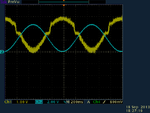yhatagishi
Junior Member level 3
Hello all,
I want to realize delta-sigma ADC using FPGA, where digital processing (the cic filter) is implemented in FPGA and only R and C are the analog parts.
LVDS is used as comparator.
The block diagram is below.

The problem is that the ADC ouput is not what I expect.
- when voltage of inputs are below 0.5 V : output is 0 V
- when voltage of inputs are near 2.5 V : output seems to be saturated around 2 V
When they are in 0.5 - 2.0 V and above 2.7 V, the output seems fine.
I drew the simple diagram of the input and output (Sorry for my bad drawing).

I am pretty sure that cic filter is working fine.
I think LVDS is the one causing those problems for the voltage that causes problems is outside the common mode voltage.
But I do not know how to deal with it...
So I want to know how I can solve those problems.
Or if anyone knows what the real problem is, please tell me.
Best regards,
Yukihiro Hatagishi
I want to realize delta-sigma ADC using FPGA, where digital processing (the cic filter) is implemented in FPGA and only R and C are the analog parts.
LVDS is used as comparator.
The block diagram is below.

The problem is that the ADC ouput is not what I expect.
- when voltage of inputs are below 0.5 V : output is 0 V
- when voltage of inputs are near 2.5 V : output seems to be saturated around 2 V
When they are in 0.5 - 2.0 V and above 2.7 V, the output seems fine.
I drew the simple diagram of the input and output (Sorry for my bad drawing).

I am pretty sure that cic filter is working fine.
I think LVDS is the one causing those problems for the voltage that causes problems is outside the common mode voltage.
But I do not know how to deal with it...
So I want to know how I can solve those problems.
Or if anyone knows what the real problem is, please tell me.
Best regards,
Yukihiro Hatagishi
Last edited:
